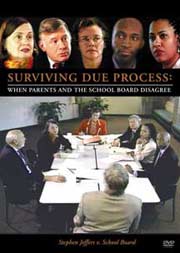|
|
|
As we enter the new year, most of us are thinking about resolutions - things we need to learn and do that will improve our lives and the lives of our children.
We have an idea for your resolution list: "I will learn how to write SMART IEPs and measurable goals."
Are you confused about IEPs? Do you believe a parent can't learn to write SMART IEPs? If the answer to these questions is "yes," it's time to reexamine your beliefs! Change the facts.
What is the most common resolution for the new year? Most people resolve to lose weight and get into better shape.
In this issue of the Special Ed Advocate, we'll teach you how to develop a SMART Weight Loss Program that is tailored to your unique needs.
You'll learn how to apply the principles of your SMART Weight Loss Program to SMART IEPs. When you apply the same principles to losing weight and developing SMART IEPs, you may lose weight as you learn!
You'll find tips, identify pitfalls, and get homework assignments, too. Learn about the Wrightslaw Game Plan for SMART IEPs, then - Pass it On!

Sign up free today! l Read previous issues |
|
| Your SMART Weight Loss Program |
The SMART Weight Loss Program that is tailored to your "unique needs" will include the following:
- Your Baseline Data (your "present levels" in pounds)
- Goals that are Specific, Measurable and Realistic
- Progress is Measured Objectively and Frequently with Scales & Tape Measure
- Goals Are Revised as You Continue to Make Progress
As you think about how to develop a SMART Weight Loss Program that is tailored to your unique needs, you will use SMART IEP principles. Your goals will be specific, measurable, use action words, realistic, and time-limited.
To learn more about how to develop a SMART Weight Loss Program and how you can apply the same principles to developing SMART IEPs, download Chapter 12 about SMART IEPs from Wrightslaw: From Emotions to Advocacy, 2nd Edition.
The SMART IEPs chapter includes homework assignments that will teach you how to write goals, and how to write SMART IEP goals.
|
back to the top |
|
| Wrightslaw Game Plan: SMART IEPs |
"Help! I need good IEP goals and objectives!"
Diane writes, "I know the goal in my son's IEP is inadequate. The goal is 'Commitment to academic success.' How are measurable goals defined? I need to see some good IEP goals!"
Mary writes, "I am a first year special education teacher and haven't had much experience with IEPs. I need to see some good IEP goals."
If the questions from this parent and teacher are familiar, you need to read the Wrightslaw Game Plan: SMART IEPs.
What makes writing IEPs so difficult?
Why is the IEP process so confusing?
When you ask for a list of "good IEP goals," you are putting the cart before the horse!
Begin at the Beginning
 IDEA 2004 requires IEPs to include a statement of the child's "present levels of academic achievement and functional performance." The present levels of performance will help you describe the child’s unique needs that result from the disability. IDEA 2004 requires IEPs to include a statement of the child's "present levels of academic achievement and functional performance." The present levels of performance will help you describe the child’s unique needs that result from the disability.
When you begin by analyzing the child’s present levels of academic achievement and functional performance, the IEP process makes sense. If you begin by trying to find "good goals and objectives," you will probably fail because the goals won’t relate to your child's unique needs.
Read the Wrightslaw Game Plan to find out why you need to begin with your child's Present Levels of Performance to develop a SMART IEP. Learn how to obtain baseline data by using your child's Present Levels of Performance.
If you have a copy of Wrightslaw: From Emotions to Advocacy, 2nd Edition, turn to page 115 to read Chapter 12: SMART IEPs.
|
back to the top |
|
| Practice Session: SMART Goals |
Which of these goals is specific?
1. Dylan will increase study skills for academic success.
2. Dylan will demonstrate the following study skills: skimming written material and use reference materials in social studies class.
Now, try writing specific goals on your own.
Which of these goals is measurable?
1. Owen will improve his reading skills.
2. Given second grade material, Owen will read a passage of text orally at 110-130 words per minute (WMP) with random errors.
Now, try writing measurable goals on your own.
Tip: SMART IEP goals are not based on district curricula, state or district tests, or other external standards.
Use the Wrightslaw method to develop SMART IEPs. For examples, tips and homework assignments, review SMART IEPs in Wrightslaw: From Emotions to Advocacy and The Wrightslaw Game Plan. |
back to the top |
|
| IEP Caselaw: What Courts Say about IEPs |
Evans v. Rhinebeck Central Sch Dist, (S.D. NY 1996) - This is an excellent case about IEPs, objective measurement of progress, and FAPE
for a child with dyslexia.
Knable v. Bexley City Sch. District (6th Cir. 2001) - This case about a child with a behavior disorder includes a good
discussion of IEPs, draft IEPs, IEP requirements, tuition
reimbursement, placement, burden of proof, and more.
Bd. of Ed of Kanawha WV v. Michael M. (W VA 2000) - One of Pete Wright's favorite cases about IEPs; includes an excellent
discussion of an "appropriate" program. Recommended reading for
attorneys who represent children with disabilities and their witnesses.
J.L. and M.L., and their minor daughter, K.L. v. Mercer Island (WA)
School District - In this case the Judge cited lack of progress in meeting IEP goals as evidence of the
district's failure to provide FAPE.
Shannon Carter v. Florence County Sch. Dist. IV. (SC 1990) - In the Carter case the Judge finds that the school's proposed IEP goals are wholly
inadequate to meet child's needs; orders tuition reimbursement for
her education in a private special education school. (Note: This case
was appealed to the U. S. Court of Appeals for the Fourth Circuit
(1991) and to the U. S. Supreme Court (1993). The Supreme Court
issued a 9-0 decision on Shannon's behalf).
Special Education Law Library l More Caselaw
|
back to the top |
|
|






